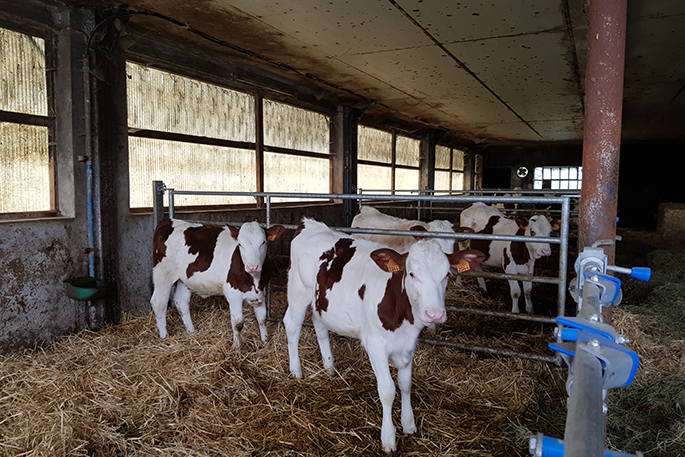Coast and Country News journalist Maddison Brown has been travelling in Europe for the last few months. Here, she tells the story of a young Frenchman’s family dairying operation.
Atop a picturesque hillside near Lyon in France lies Clément Rivoire’s 90-hectare family dairy farm. Situated 900m above sea level on steep terrain and plummeting to temperatures as low as minus 20 degrees Celsius in winter, dairying for this young Frenchman varies greatly from any in New Zealand.
Clément, a 29-year-old farmer who spent one year working on a dairy farm in New Zealand works alongside his semi-retired parents Christian and Anne-Marie Rivoire on the family farm.
Recently purchasing two neighbouring farms and increasing herd numbers to 85, they farm a traditional French breed beef and dairy cross called Montbeliarde, which is famed for excellent cheese-making milk. A hands-on farming approach, calving year-round and cows being kept inside every night and 24/7 during the winter keeps the young farmer busy around the clock.
“We milked 71 cows today, but on average we milk 75 to 80. In total we have 85 cows including the dry cows. We always have some dry cows, and with calves we have 50 heifers,” says Clément.
Milk solids and beef
“Mostly in France to make milk we use Friesian, the second breed is Montbeliarde because it produces less milk but a bit more milk solid and also a lot more beef. We use this breed because we can use it for beef as well. Montbeliarde has about 400kg of meat, which is a lot more than a Jersey. We crossbreed a part of the herd with Charolais and we sell the calves at one month of age to the market. We sell the male for €500 (NZ$840) and the female for €350 (NZ$587),” says Clément.
French farmers are paid by the litre of milk, with bonuses for milk solids resulting in calving year-round being necessary. A brand-new purpose-built barn takes pride of place on one of the three farming blocks, complete with an effluent tank capable of holding 4.5 months’ full-time effluent, an indoor grain silo and milk vat, freestyle stalls complete with a rubber-covered foam mattresses for comfort, a feeding area that is easily accessible by tractor and a large calving pen allowing cows to have additional space without being separated from the herd when calving.
“We have a very windy place, so ventilation in the barn is very easy, that’s why we built a wide barn – 1800m2 in total – the cows will come inside between November 1 and 15, and they will go back outside around April 1. But this year it was too cold,” says Clément.
“Most barns are like this now [rubber matting] because if you are not very clean with your straw, you can have more mastitis problems. Since we’ve had our new shed we’ve only had five or six mastitis cases in one-and-a-half years. Our average [somatic] cell count is under 100. To be paid the full price in France you have to be under 250 SCC – and after three times of being over 400 they will stop picking up your milk,” says Clément.
His vat stands horizontal – as required for the milk-truck driver to measure the level of milk from top at pick-up.
NZ techniques
“Also because we keep the vat inside for the winter, because it is too cold, it is easier to keep a horizontal one inside than a vertical one,” says Clément.
Newborn calves are kept in a separate room within the barn, then transported back to the old stone barn where they live on fresh straw until they are six months old and the weather is warm enough for them to be paddocked during the day. They’re mated at 18 months old – and at any one time they have around 50 heifers of varying ages, says Clément.
Spending one year living in NZ with his wife Mathilde, Clément utilises many techniques he learnt while working on a dairy farm in Southland.
“We leave the calves with the mother for two-three hours then we drench and tube them, which is something I learnt in New Zealand…it is working well,” says Clément.
The cows are fed a combination of grass, silage, wheat, barley, and alfalfa to produce protein – all of which they grow on-farm. During winter, rapeseed and soy are added to the cows’ diets to increase protein intake. Since the cows are kept inside 24/7 during winter, all effluent is held in large holding tanks and spread during summer months, which is done manually.
“We try to buy the least food as; and we spread the effluent ourselves with a tractor and a tank,” says Clément.
Purpose-built barn
The purpose-built barn is complete with mechanical guides for milking, which direct the cows to allow for one-man milking. They milk in a perpendicular formation rather than in herringbone, which Clément says is around the same square meterage but allows for 12-aside milking. Each time a cow is milked their teats are cleaned with a disinfectant foam, which helps reduce mastitis.
“During winter they are dirtier than outside, so it is better if we clean the teats. We are penalised if they find faecal matter in the milk, so we don’t want that to happen,” says Clément.
Looking to the future, Clément intends to renovate one of the original 150-year-old farm houses as a family home.



0 Comments
Leave a Comment